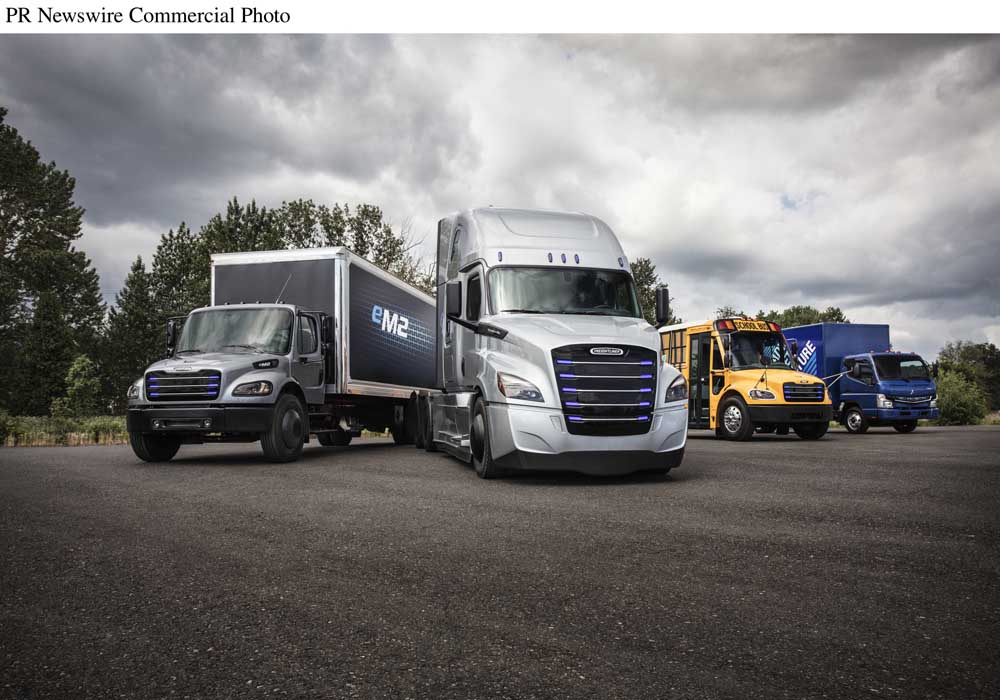Daimler vision of future in Oregon: self-driving semis, electric buses
Published 9:00 am Thursday, June 14, 2018

- Daimler Trucks line-up of commercial electric vehicles, from left to right): Freightliner eM2, Freightliner eCascadia, Thomas Built Buses Saf-T-Liner C2 Jouley, FUSO eCanter (PRNewsfoto/Daimler North America - Corporate)
Daimler Trucks announced this week it will invest millions to develop an automated trucking research center at its North American headquarters in Swan Island on the Willamette River.
Daimler showcased three large electric vehicles — a school bus and two trucks it hopes will appeal to school districts and commercial fleet operators looking to improve air quality. The developments were part of an event Daimler held Wednesday in Portland to unveil a high-tech vision of the future for industry analysts and journalists.
The company said it doesn’t expect self-driving commercial trucks “in the near future,” but it does believe some automation may be practical well before that — using technology to warn of potential collisions or to pair trucks on the highway to improve efficiency.
The company is already testing these platooned trucks on Interstate 84 and at its test track in Madras.
The new Portland research center would be the hub for automation research, with engineers there working with Daimler colleagues in Germany and Italy. Even fairly basic automation could significantly reduce collisions, according to Roger Nielsen, CEO of Daimler Trucks North America.
He expects the German parent company will introduce its technology in the United States first.
“We think the first applications for the higher levels of automation are here in America because of the higher distances traveled,” Nielsen said.
Daimler showed off a new electric school bus, called Jouley, with a range of up to 100 miles. School buses are an ideal spot to begin electrification, according to the company, because short, predictable routes provide time to recharge and because of the health hazards from diesel exhaust.
“The discussion begins with governmental agencies trying to reduce the amount of the emissions, especially in places like California,” Nielsen said.
A conventional diesel school bus might cost $100,000 or more, Nielsen said. Daimler hasn’t announced pricing for its electric buses, but he said they would likely cost two or three times that. But Nielsen said California and other states are offering six-figure incentives to persuade bus companies to switch from diesel. That’s enough to kick-start the market, he said, and Daimler plans to begin shipping its Jouley buses in limited quantities next year.
Ultimately, Daimler is counting on innovation to bring the cost down dramatically. “The government incentives will help ease the pain, but as it gets to higher levels of adoption it has to pay for itself,” Nielsen said.
Electric semis are further off. Daimler said it plans to ship 30 test vehicles to customers this year but doesn’t plan to begin regular production until 2021.
The trucks Daimler showed off Wednesday were nearly silent, a dramatic contrast to diesel’s traditional rumble. They have ranges from 230 to 250 miles and can recharge 80 percent of their battery in 60 to 90 minutes, depending on the model.
Daimler said it believes there’s a market for these trucks in short-haul routes within cities — to and from a port, for example, or on a delivery route.
Daimler didn’t set pricing for the trucks yet but said the initial models will also be multiple times more expensive than a standard diesel truck.






